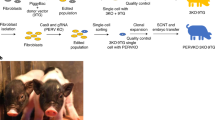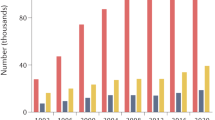Abstract
In this review, we summarize the work published over the last 2 years using genetic modifications of animals in the field of xenotransplantation. Genetic engineering of the donor has become a powerful tool in xenotransplantation, both for the inactivation of one particular porcine gene and for the addition of human genes with the goal of overcoming xenogeneic barriers. We summarize the work relative to the knockout of the α1,3-galactosyltransferase gene, followed by genetic engineering aimed at reducing the humoral and cellular immune response, complement activation and coagulation. Finally, we report on the genetic modification of pigs to reduce porcine endogenous retrovirus infection risk in the xenogeneic context.
This is a preview of subscription content, access via your institution
Access options
Subscribe to this journal
Receive 12 print issues and online access
$259.00 per year
only $21.58 per issue
Buy this article
- Purchase on Springer Link
- Instant access to full article PDF
Prices may be subject to local taxes which are calculated during checkout

Similar content being viewed by others
References
Watanabe S, Misawa M, Matsuzaki T, Sakurai T, Muramatsu T, Yokomine TA et al. Production and characterization of transgenic mice systemically expressing endo-beta-galactosidase C. Glycobiology 2008; 18: 9–19.
Matsunami K, Miyagawa S, Nakagawa K, Otsuka H, Shirakura R . Molecular cloning of pigGnT-I and I.2: an application to xenotransplantation. Biochem Biophys Res Commun 2006; 343: 677–683.
Milland J, Christiansen D, Lazarus BD, Taylor SG, Xing PX, Sandrin MS . The molecular basis for galalpha(1,3)gal expression in animals with a deletion of the alpha1,3galactosyltransferase gene. J Immunol 2006; 176: 2448–2454.
Nottle MB, Beebe LF, Harrison SJ, McIlfatrick SM, Ashman RJ, O'Connell PJ et al. Production of homozygous alpha-1,3-galactosyltransferase knockout pigs by breeding and somatic cell nuclear transfer. Xenotransplantation 2007; 14: 339–344.
Ezzelarab M, Cortese-Hassett A, Cooper DK, Yazer MH . Extended coagulation profiles of healthy baboons and of baboons rejecting GT-KO pig heart grafts. Xenotransplantation 2006; 13: 522–528.
Hara H, Ezzelarab M, Rood PP, Lin YJ, Busch J, Ibrahim Z et al. Allosensitized humans are at no greater risk of humoral rejection of GT-KO pig organs than other humans. Xenotransplantation 2006; 13: 357–365.
Zahorsky-Reeves JL, Kearns-Jonker MK, Lam TT, Jackson JR, Morris RE, Starnes VA et al. The xenoantibody response and immunoglobulin gene expression profile of cynomolgus monkeys transplanted with hDAF-transgenic porcine hearts. Xenotransplantation 2007; 14: 135–144.
Deppenmeier S, Bock O, Mengel M, Niemann H, Kues W, Lemme E et al. Health status of transgenic pigs expressing the human complement regulatory protein CD59. Xenotransplantation 2006; 13: 345–356.
Poling J, Oezkur M, Kogge K, Mengel M, Niemann H, Winkler M et al. Hyperacute rejection in ex vivo-perfused porcine lungs transgenic for human complement regulatory proteins. Transpl Int 2006; 19: 225–232.
Wu G, Pfeiffer S, Schroder C, Zhang T, Nguyen BN, Kelishadi S et al. Coagulation cascade activation triggers early failure of pig hearts expressing human complement regulatory genes. Xenotransplantation 2007; 14: 34–47.
Liu D, Kobayashi T, Onishi A, Furusawa T, Iwamoto M, Suzuki S et al. Relation between human decay-accelerating factor (hDAF) expression in pig cells and inhibition of human serum anti-pig cytotoxicity: value of highly expressed hDAF for xenotransplantation. Xenotransplantation 2007; 14: 67–73.
Smolenski RT, Forni M, Maccherini M, Bacci ML, Slominska EM, Wang H et al. Reduction of hyperacute rejection and protection of metabolism and function in hearts of human decay accelerating factor (hDAF)-expressing pigs. Cardiovasc Res 2007; 73: 143–152.
Manzi L, Montano R, Abad MJ, Arsenak M, Romano E, Taylor P . Expression of human soluble complement receptor 1 by a pig endothelial cell line inhibits lysis by human serum. Xenotransplantation 2006; 13: 75–79.
Godwin JW, Fisicaro N, d'Apice AJ, Cowan PJ . Towards endothelial cell-specific transgene expression in pigs: characterization of the pig ICAM-2 promoter. Xenotransplantation 2006; 13: 514–521.
Dwyer KM, Mysore TB, Crikis S, Robson SC, Nandurkar H, Cowan PJ et al. The transgenic expression of human CD39 on murine islets inhibits clotting of human blood. Transplantation 2006; 82: 428–432.
Mitsuhashi N, Fischer-Lougheed J, Shulkin I, Kleihauer A, Kohn DB, Weinberg KI et al. Tolerance induction by lentiviral gene therapy with a nonmyeloablative regimen. Blood 2006; 107: 2286–2293.
Fischer-Lougheed JY, Tarantal AF, Shulkin I, Mitsuhashi N, Kohn DB, Lee CC et al. Gene therapy to inhibit xenoantibody production using lentiviral vectors in non-human primates. Gene Therapy 2007; 14: 49–57.
Mulley WR, Wee JL, Christiansen D, Milland J, Ierino FL, Sandrin MS . Lentiviral expression of CTLA4Ig inhibits primed xenogeneic lymphocyte proliferation and cytokine responses. Xenotransplantation 2006; 13: 248–252.
Jeon DH, Oh K, Oh BC, Nam DH, Kim CH, Park HB et al. Porcine PD-L1: cloning, characterization, and implications during xenotransplantation. Xenotransplantation 2007; 14: 236–242.
Lilienfeld BG, Crew MD, Forte P, Baumann BC, Seebach JD . Transgenic expression of HLA-E single chain trimer protects porcine endothelial cells against human natural killer cell-mediated cytotoxicity. Xenotransplantation 2007; 14: 126–134.
Dieckhoff B, Karlas A, Hofmann A, Kues WA, Petersen B, Pfeifer A et al. Inhibition of porcine endogenous retroviruses (PERVs) in primary porcine cells by RNA interference using lentiviral vectors. Arch Virol 2007; 152: 629–634.
Dieckhoff B, Petersen B, Kues WA, Kurth R, Niemann H, Denner J . Knockdown of porcine endogenous retrovirus (PERV) expression by PERV-specific shRNA in transgenic pigs. Xenotransplantation 2008; 15: 36–45.
Yang H, Zhong R . Satellite Symposium on Xenotransplantation-D. Session ‘Renal Transplantation’-(1) The role of anti-non-Gal antibodies in xenograft rejection in a pig-to-baboon kidney transplantation model. Xenotransplantation 2007; 14: 184–186.
Cowan PJ . Coagulation and the xenograft endothelium. Xenotransplantation 2007; 14: 7–12.
Roussel JC, Moran CJ, Salvaris EJ, Nandurkar HH, d'Apice AJ, Cowan PJ . Pig thrombomodulin binds human thrombin but is a poor cofactor for activation of human protein C and TAFI. Am J Transplant 2008; 8: 1101–1112.
Kitchens WH, Uehara S, Chase CM, Colvin RB, Russell PS, Madsen JC . The changing role of natural killer cells in solid organ rejection and tolerance. Transplantation 2006; 81: 811–817.
Lilienfeld BG, Garcia-Borges C, Crew MD, Seebach JD . Porcine UL16-binding protein 1 expressed on the surface of endothelial cells triggers human NK cytotoxicity through NKG2D. J Immunol 2006; 177: 2146–2152.
Pierson RN . Primate T-cell responses to porcine antigens: implications for clinical xenotransplantation. Xenotransplantation 2006; 13: 14–18.
Sprangers B, Waer M, Billiau AD . Xenotransplantation: where are we in 2008? Kidney Int 2008; 74: 14–21.
Cooper DK, Dorling A, Pierson III RN, Rees M, Seebach J, Yazer M et al. Alpha1,3-galactosyltransferase gene-knockout pigs for xenotransplantation: where do we go from here? Transplantation 2007; 84: 1–7.
Tai HC, Ezzelarab M, Hara H, Ayares D, Cooper DK . Progress in xenotransplantation following the introduction of gene-knockout technology. Transpl Int 2007; 20: 107–117.
Porubsky S, Speak AO, Luckow B, Cerundolo V, Platt FM, Grone HJ . Normal development and function of invariant natural killer T cells in mice with isoglobotrihexosylceramide (iGb3) deficiency. Proc Natl Acad Sci USA 2007; 104: 5977–5982.
Sandrin MS . Gal knockout pigs: any more carbohydrates? Transplantation 2007; 84: 8–9.
d'Apice AJ, Cowan PJ . Building on the GalKO platform. Transplantation 2007; 84: 10–11.
Salvaris EJ, Harrison S, Beebe LF, Dwyer KM, Crikis S, Hawthorne WJ et al. Generation of a Gal knockout pig expressing human CD39. Xenotransplantation 2007; 14: 417–418.
Petersen B, Lucas-Hahn A, Lemme E, Hermann D, Barg-Kues B, Carnwath JW et al. Production and characterization of pigs transgenic for human thrombomodulin. Xenotransplantation 2007; 14: 371.
Acknowledgements
Xenotransplantation research in our laboratory is supported by an integrated project grant from the European Union (no. LSHB-CT-2006-037377) within the sixth Framework Program, Xenome consortium, as well as by the Fondations Centaure and Progreffe and INSERM.
Author information
Authors and Affiliations
Corresponding author
Rights and permissions
About this article
Cite this article
Le Bas-Bernardet, S., Anegon, I. & Blancho, G. Progress and prospects: genetic engineering in xenotransplantation. Gene Ther 15, 1247–1256 (2008). https://doi.org/10.1038/gt.2008.119
Received:
Revised:
Accepted:
Published:
Issue Date:
DOI: https://doi.org/10.1038/gt.2008.119
Keywords
This article is cited by
-
Identification by mass spectrometry and immunoblotting of xenogeneic antigens in the N- and O-glycomes of porcine, bovine and equine heart tissues
Glycoconjugate Journal (2020)
-
Transgenesis and genome analysis, Nantes, France, June 6th 2011
Transgenic Research (2012)



